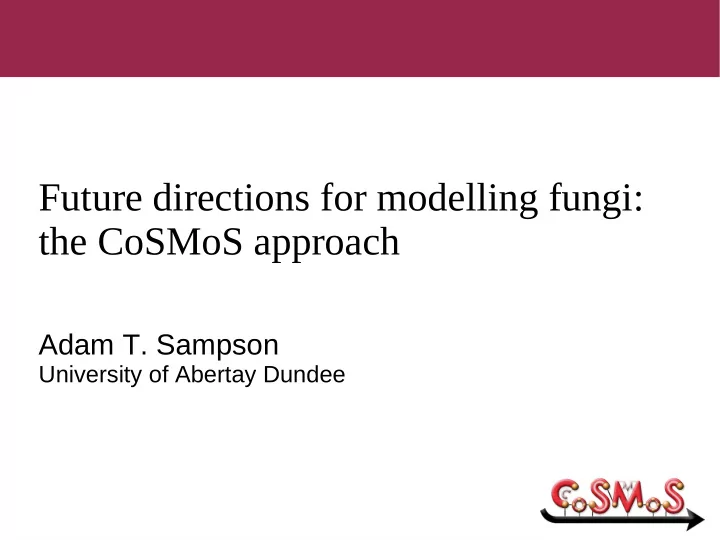

Future directions for modelling fungi: the CoSMoS approach Adam T. Sampson University of Abertay Dundee
The CoSMoS project ● Developing generic, dependable techniques for co mplex s ystems mo delling and s imulation across all fields of scientific experimentation ● £1.5m EPSRC project, Oct 2007 – Mar 2012 ● RA working on modelling; RA on simulation ● 5+ RSs working on case studies ● Several institutions: York, Kent, Abertay, UWE
CoSMoS principles ● Simulation is a scientific instrument – Don’t just build your simulation ad-hoc! – Must understand limitations/assumptions ● An engineering approach to complex systems: identify and develop existing best practices – Design patterns – Agile software engineering practices – Structured argumentation ● Drawn from real-world case studies – Working alongside domain experts
Case study: lymphocyte rolling ● Lymphocytes move from bloodstream into lymph node ● York immunologists wanted to experiment in-silico with HEV size’s effect on migration rate ● Based on distributed space model from earlier CoSMoS work
Case study: granuloma formation ● Granulomas form to contain infected cells in the liver ● What effect does the network structure have? ● Multiple ideas of space: physical, graph- based ● Tools for data analysis
The challenge of scalability ● Small simulations are easy to build... – … but we want to operate at realistic scales, simulating millions of agents ● We need to use modern parallel hardware: multicore CPUs and clusters of machines – … but how do you build parallel simulations? – Take advantage of natural concurrency! ● CoSMoS design patterns show how to use concurrent programming techniques to build reliable, massively-scalable simulations
Case study: birds on the wall
Case study: fungal growth ● Student project at York: Matthew Harbage reimplemented Ruth Falconer’s existing model of fungal growth using CoSMoS techniques – Original model used PDEs to describe behaviour of units of biomass – Converted into behaviours in agent-based model ● Reused CoSMoS continuous space model – Added facilities for simulating resources in the environment efficiently as agents
Case study: fungal growth ● Reproduced the behaviour of the existing simulation ● But this is scalable : we can make it arbitrarily large, run it on a cluster of machines, etc. ● Simulation techniques have fed into later CoSMoS work
Where next? ● CoSMoS still has a year and a bit to run, and we’re putting together follow-up projects now... ● Multiscale and multilevel models – e.g. fungus growing in soil – with the soil modelled in detail at a lower level, as appropriate ● Higher-level tools for building simulations – Make it easier to use our design patterns ● Better tools for analysing and visualising results – Make in-silico experimentation more accessible
Any questions? More information on CoSMoS: http://www.cosmos-research.org/ See the simulations in action: http://www.youtube.com/user/atscosmos
Recommend
More recommend